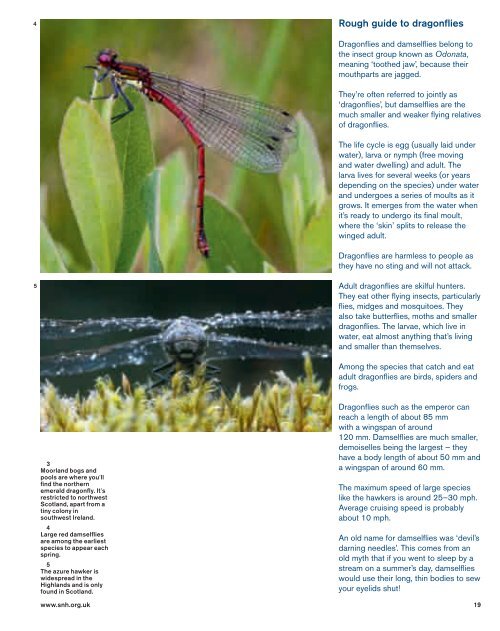Summer 2009 - Scottish Natural Heritage
Summer 2009 - Scottish Natural Heritage
Summer 2009 - Scottish Natural Heritage
You also want an ePaper? Increase the reach of your titles
YUMPU automatically turns print PDFs into web optimized ePapers that Google loves.
4<br />
Rough guide to dragonflies<br />
Dragonfl ies and damselfl ies belong to<br />
the insect group known as Odonata,<br />
meaning ‘toothed jaw’, because their<br />
mouthparts are jagged.<br />
They’re often referred to jointly as<br />
‘dragonfl ies’, but damselfl ies are the<br />
much smaller and weaker fl ying relatives<br />
of dragonfl ies.<br />
The life cycle is egg (usually laid under<br />
water), larva or nymph (free moving<br />
and water dwelling) and adult. The<br />
larva lives for several weeks (or years<br />
depending on the species) under water<br />
and undergoes a series of moults as it<br />
grows. It emerges from the water when<br />
it’s ready to undergo its fi nal moult,<br />
where the ‘skin’ splits to release the<br />
winged adult.<br />
Dragonfl ies are harmless to people as<br />
they have no sting and will not attack.<br />
5<br />
Adult dragonfl ies are skilful hunters.<br />
They eat other fl ying insects, particularly<br />
fl ies, midges and mosquitoes. They<br />
also take butterfl ies, moths and smaller<br />
dragonfl ies. The larvae, which live in<br />
water, eat almost anything that’s living<br />
and smaller than themselves.<br />
Among the species that catch and eat<br />
adult dragonfl ies are birds, spiders and<br />
frogs.<br />
3<br />
Moorland bogs and<br />
pools are where you’ll<br />
find the northern<br />
emerald dragonfly. It’s<br />
restricted to northwest<br />
Scotland, apart from a<br />
tiny colony in<br />
southwest Ireland.<br />
4<br />
Large red damselflies<br />
are among the earliest<br />
species to appear each<br />
spring.<br />
5<br />
The azure hawker is<br />
widespread in the<br />
Highlands and is only<br />
found in Scotland.<br />
Dragonfl ies such as the emperor can<br />
reach a length of about 85 mm<br />
with a wingspan of around<br />
120 mm. Damselfl ies are much smaller,<br />
demoiselles being the largest – they<br />
have a body length of about 50 mm and<br />
a wingspan of around 60 mm.<br />
The maximum speed of large species<br />
like the hawkers is around 25–30 mph.<br />
Average cruising speed is probably<br />
about 10 mph.<br />
An old name for damselfl ies was ‘devil’s<br />
darning needles’. This comes from an<br />
old myth that if you went to sleep by a<br />
stream on a summer’s day, damselfl ies<br />
would use their long, thin bodies to sew<br />
your eyelids shut!<br />
www.snh.org.uk 19

















